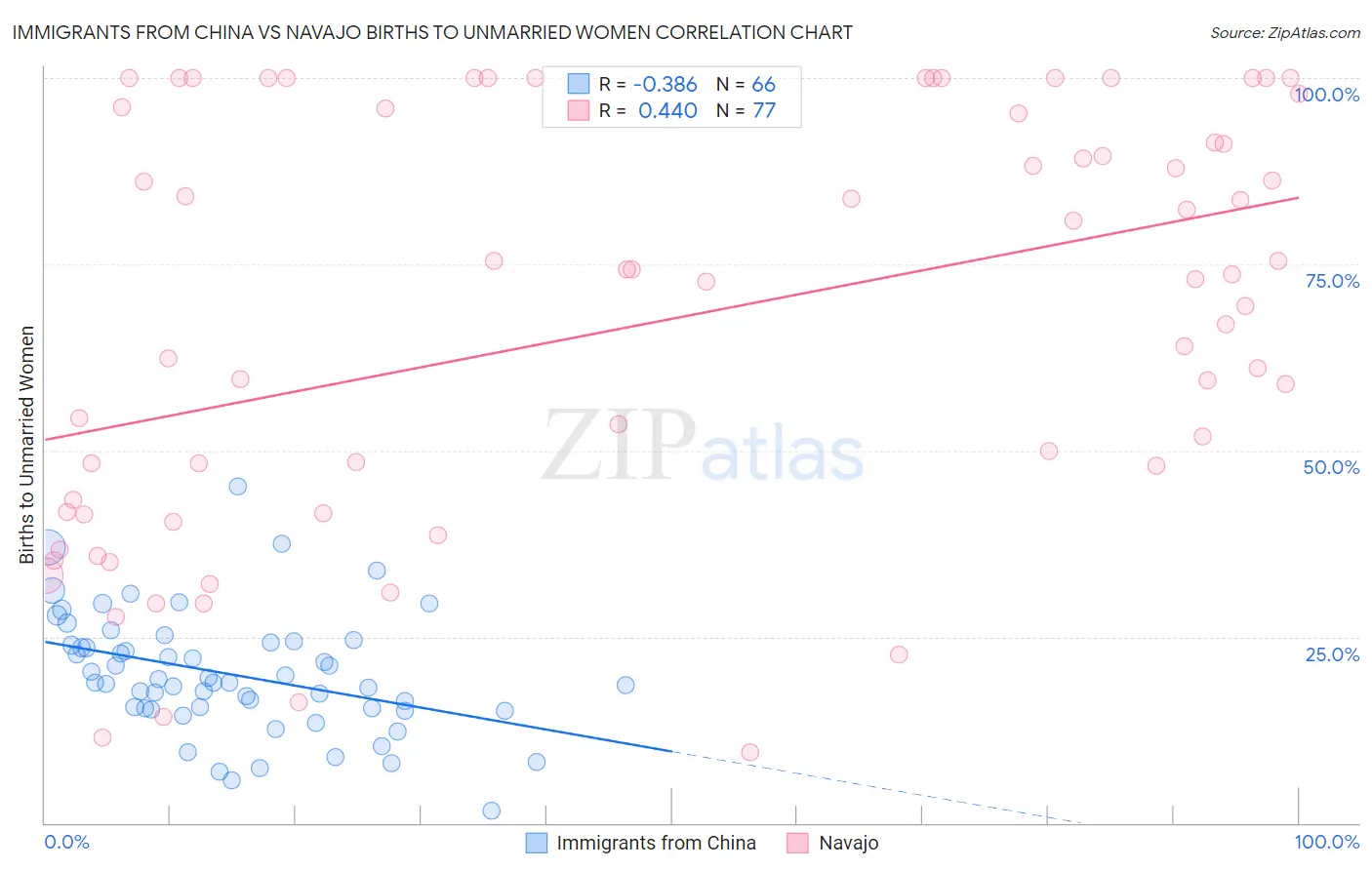Immigrants from China vs Navajo Births to Unmarried Women
COMPARE
Immigrants from China
Navajo
Births to Unmarried Women
Births to Unmarried Women Comparison
Immigrants from China
Navajo
24.7%
BIRTHS TO UNMARRIED WOMEN
100.0/ 100
METRIC RATING
8th/ 347
METRIC RANK
51.5%
BIRTHS TO UNMARRIED WOMEN
0.0/ 100
METRIC RATING
344th/ 347
METRIC RANK
Immigrants from China vs Navajo Births to Unmarried Women Correlation Chart
The statistical analysis conducted on geographies consisting of 420,563,672 people shows a mild negative correlation between the proportion of Immigrants from China and percentage of births to unmarried women in the United States with a correlation coefficient (R) of -0.386 and weighted average of 24.7%. Similarly, the statistical analysis conducted on geographies consisting of 217,645,361 people shows a moderate positive correlation between the proportion of Navajo and percentage of births to unmarried women in the United States with a correlation coefficient (R) of 0.440 and weighted average of 51.5%, a difference of 108.7%.

Births to Unmarried Women Correlation Summary
| Measurement | Immigrants from China | Navajo |
| Minimum | 1.6% | 9.5% |
| Maximum | 45.2% | 100.0% |
| Range | 43.6% | 90.5% |
| Mean | 19.9% | 67.3% |
| Median | 18.9% | 72.9% |
| Interquartile 25% (IQ1) | 15.3% | 41.6% |
| Interquartile 75% (IQ3) | 24.2% | 95.6% |
| Interquartile Range (IQR) | 8.9% | 54.0% |
| Standard Deviation (Sample) | 8.1% | 27.7% |
| Standard Deviation (Population) | 8.0% | 27.6% |
Similar Demographics by Births to Unmarried Women
Demographics Similar to Immigrants from China by Births to Unmarried Women
In terms of births to unmarried women, the demographic groups most similar to Immigrants from China are Immigrants from South Central Asia (24.7%, a difference of 0.010%), Immigrants from Eastern Asia (25.0%, a difference of 1.5%), Immigrants from Israel (25.1%, a difference of 1.9%), Indian (Asian) (25.3%, a difference of 2.4%), and Iranian (25.3%, a difference of 2.5%).
| Demographics | Rating | Rank | Births to Unmarried Women |
| Assyrians/Chaldeans/Syriacs | 100.0 /100 | #1 | Exceptional 22.0% |
| Immigrants | India | 100.0 /100 | #2 | Exceptional 22.9% |
| Filipinos | 100.0 /100 | #3 | Exceptional 23.0% |
| Immigrants | Taiwan | 100.0 /100 | #4 | Exceptional 23.0% |
| Immigrants | Hong Kong | 100.0 /100 | #5 | Exceptional 23.6% |
| Immigrants | Iran | 100.0 /100 | #6 | Exceptional 24.0% |
| Thais | 100.0 /100 | #7 | Exceptional 24.0% |
| Immigrants | China | 100.0 /100 | #8 | Exceptional 24.7% |
| Immigrants | South Central Asia | 100.0 /100 | #9 | Exceptional 24.7% |
| Immigrants | Eastern Asia | 100.0 /100 | #10 | Exceptional 25.0% |
| Immigrants | Israel | 100.0 /100 | #11 | Exceptional 25.1% |
| Indians (Asian) | 100.0 /100 | #12 | Exceptional 25.3% |
| Iranians | 100.0 /100 | #13 | Exceptional 25.3% |
| Immigrants | Lebanon | 100.0 /100 | #14 | Exceptional 25.3% |
| Immigrants | Singapore | 100.0 /100 | #15 | Exceptional 25.6% |
Demographics Similar to Navajo by Births to Unmarried Women
In terms of births to unmarried women, the demographic groups most similar to Navajo are Pima (51.5%, a difference of 0.040%), Menominee (51.1%, a difference of 0.74%), Inupiat (52.1%, a difference of 1.2%), Hopi (50.8%, a difference of 1.3%), and Tohono O'odham (49.8%, a difference of 3.3%).
| Demographics | Rating | Rank | Births to Unmarried Women |
| Blacks/African Americans | 0.0 /100 | #333 | Tragic 44.3% |
| Yuman | 0.0 /100 | #334 | Tragic 44.4% |
| Colville | 0.0 /100 | #335 | Tragic 45.3% |
| Puerto Ricans | 0.0 /100 | #336 | Tragic 45.7% |
| Houma | 0.0 /100 | #337 | Tragic 46.6% |
| Arapaho | 0.0 /100 | #338 | Tragic 47.1% |
| Lumbee | 0.0 /100 | #339 | Tragic 48.2% |
| Tohono O'odham | 0.0 /100 | #340 | Tragic 49.8% |
| Hopi | 0.0 /100 | #341 | Tragic 50.8% |
| Menominee | 0.0 /100 | #342 | Tragic 51.1% |
| Pima | 0.0 /100 | #343 | Tragic 51.5% |
| Navajo | 0.0 /100 | #344 | Tragic 51.5% |
| Inupiat | 0.0 /100 | #345 | Tragic 52.1% |
| Pueblo | 0.0 /100 | #346 | Tragic 53.7% |
| Yup'ik | 0.0 /100 | #347 | Tragic 56.4% |